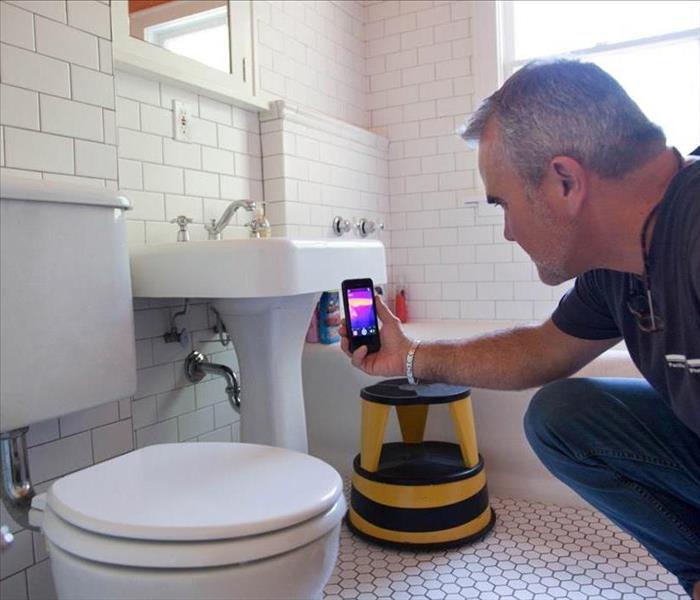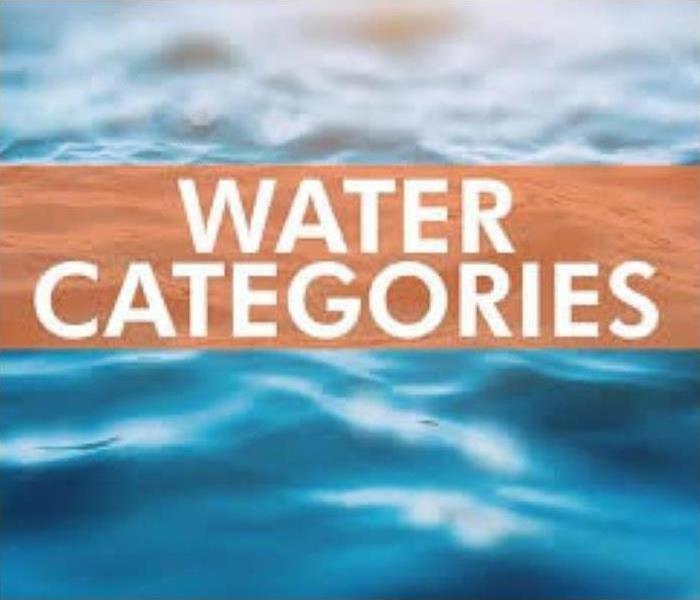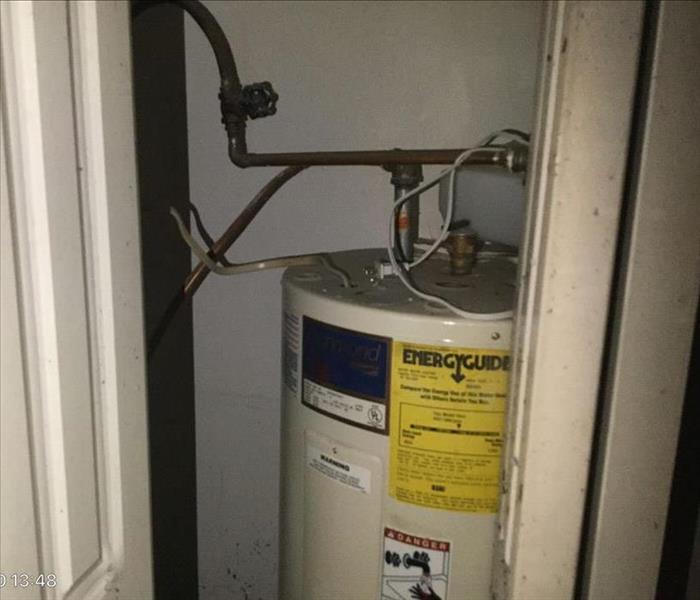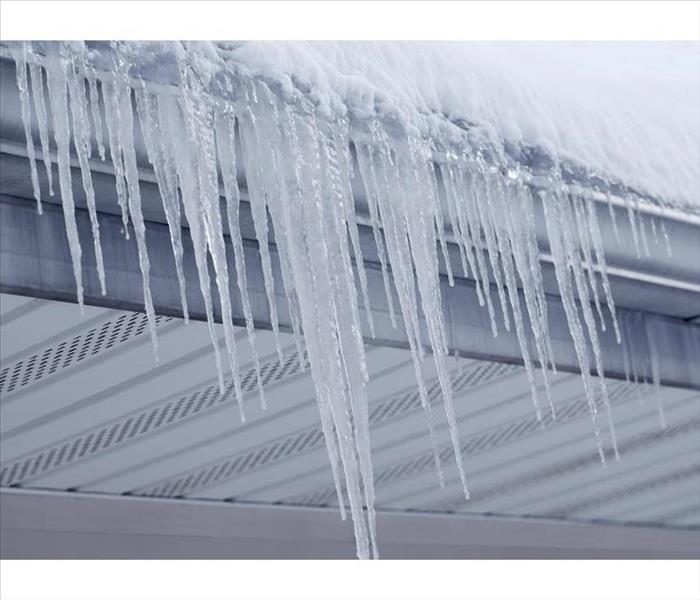Recent Water Damage Posts
How long does it take for water damage to set in?
4/1/2024 (Permalink)
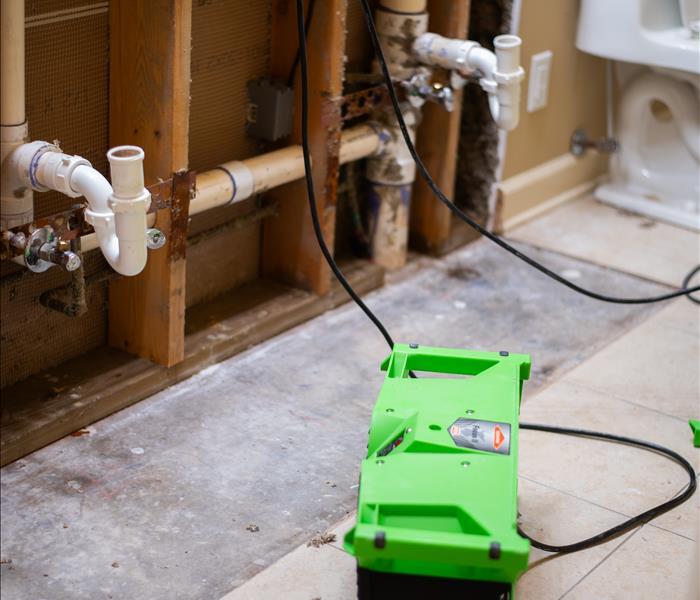 This bathroom flooded after a pipe connected to the water heater ruptured and spread throughout the home.
This bathroom flooded after a pipe connected to the water heater ruptured and spread throughout the home.
How long does it take for water damage to set in?
When you discover you have had a water intrusion in your home, you will have a lot of questions. How long has this water been sitting here? What do we do? Who do we call? How much time do we have to get this cleaned up?
With any type of water damage, time is of the essence. A quick response is crucial to prevent water from causing its peak potential damage. It does not take very long for water to cause problems, but the longer it sits, the worse it will get. That also means that repairs will take longer and become more expensive.
We have compiled this timeline to demonstrate just how quickly water damage sets in and what can happen if left for too long.
Within Minutes
- Water quickly spreads throughout your property, saturating everything in its path.
- Water absorbs into walls, floors, upholstery, and other belongings.
- Furniture finishes may bleed, causing permanent staining on carpets.
- Photographs, books, and other paper goods start to swell and warp.
Hours 1 - 24:
- Drywall begins to swell and break down.
- Metal surfaces start to tarnish.
- Furniture begins to swell and crack.
- Dyes and inks from cloth and paper goods spread and stain.
- A musty odor appears.
48 Hours to 1 Week:
- Mold and mildew may grow and spread.
- Doors, windows, and studs swell and warp.
- Metal begins to rust and corrode.
- Furniture warps and shows signs of mold.
- Paint begins to blister.
- Wood flooring swells and warps.
- Serious biohazard contamination is possible.
More Than 1 Week:
- Restoration time and cost increase dramatically; replacing contaminated materials and structural rebuilding may be extensive.
- Structural safety, mold growth, and biohazard contaminants pose serious risks to occupants.
About SERVPRO of Saline County and Hot Springs
SERVPRO of Saline County and Hot Springs specializes in the cleanup and restoration of residential and commercial property after a water damage event. Our team understands the importance of responding to water damage quickly, that is why we offer 24/7 emergency services so that our professional crews can get to work quickly, minimizing the potential damage to your property and returning it to “preloss” condition as soon as possible.
Our staff is highly trained in property damage restoration. From initial and ongoing training at SERVPRO’s corporate training facility to regular IICRC-industry certifications.
I have standing water in my home: What do I do now?
1/4/2024 (Permalink)
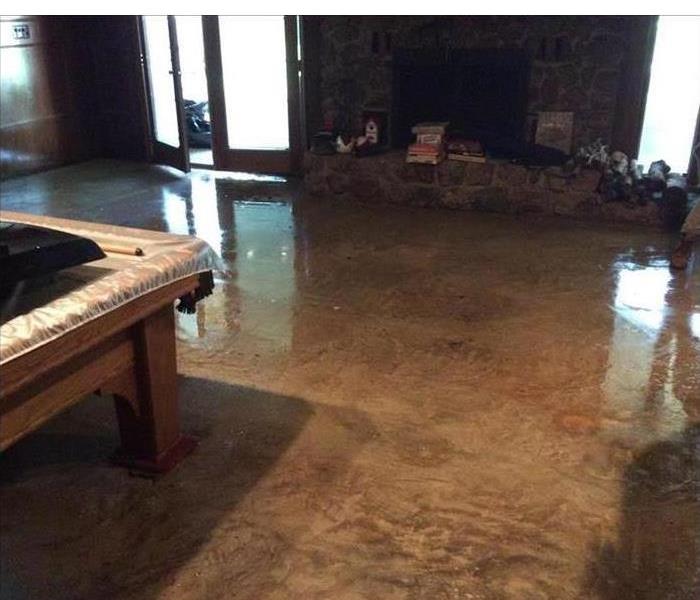 A flood that started in the kitchen, quickly spread to affect the living room in this home.
A flood that started in the kitchen, quickly spread to affect the living room in this home.
Broken water supply lines
In the last several years home appliances have made many technological advancements that continue to make our lives easier. Washing machines, dishwashers, refrigerators, and ice makers bring convenience, ease, and even the feeling of luxury to our everyday lives. However, the water lines that supply these devices can sometimes fail or break, causing water to flow freely and spread throughout your home.
If this unfortunate incident does occur in your home, the most important thing you can do is immediately call for help. SERVPRO® of Saline County and SERVPRO® of Hot Springs are available 24/7 for emergency water services. Letting this water sit for any extended period, will only lead to compounding damage. Moisture will continue to absorb into the structure of your home, leading to weakening and distortion. Hardwood flooring will begin to bubble, warp, or even crack from swelling up with moisture.
While you are waiting for SERVPRO® of Saline County and Hot Springs to arrive, here are some actions you can take to help prevent further damage:
- Make sure you are safe.
- Watch for electrical hazards and always err on the side of caution.
- Water-soaked items will be heavier than usual, so be careful when lifting and do not lift with your back.
- Watch your step and take precautions to not slip.
- Shut off the water
- Locate your main water valve and shut the water off.
- Repair leaks or damage
- If the water loss was caused by a leak or broken pipe, be sure to have the source repaired as quickly as possible. Neutralizing the source will help prevent the loss from happening again or worsening.
- Move personal items out of the way.
- If there are loose items on the floor, do your best to pick them up and move them out of the way.
- If there are items that you can safely move by yourself, such as art or dining chairs, move them to another location to prevent them from becoming damaged.
- Move wet upholstery and cushions to a dry place.
- Turn on your A/C (in the summertime)
- Turning on your HVAC can help begin the drying process.
If you have experienced a water loss in your home, SERVPRO® of Saline County and Hot Springs is here to help.®
Call us any time of day or day of the week. 501-803-9700
How to Discover a Water Leak in Your Bathroom
9/20/2022 (Permalink)
Indoor plumbing is one luxury of modern life, but a bathtub leak can quickly turn it into a stressful, expensive problem. If you want to prevent a water disaster from damaging your home, there are signs you can look for. Here are a few ways to find potential water leaks in your tub or shower.
Look for Signs
If you suspect you have a shower pan leak, there are several telltale signs you can search for. Here are some signs to look for when inspecting your home for leaks:
- Damp carpet
- Rusted floor nails
- Stains on the shower stall
- Water in the ceiling or light fixtures below
- Wet drywall
Some signs may not be immediately apparent, but you can do simple things to uncover them, such as pulling back a corner of the carpet to look for rusty floor nails. Another easy task is to inspect the drywall and floor surrounding the shower (or the ceiling on the floor below if you have a multi-story home). Some leaks may not be apparent while the water is off, so running the water while you search may make the leak easier to find.
Perform a Test
If you’re building a home in Saline County or remodeling an existing bathroom, a bathtub leak test may be appropriate. This a test often performed by professionals during home construction, so ask your contractor about it. To do the test, he or she will stop the drain, fill the tub to capacity and let it stand for at least 48 hours. It’s a simple way to discover potential leaks before other water damage-prone materials are installed.
Unfortunately, sometimes a bathtub leak isn’t discovered until the damage is already done, but a water damage repair specialist can help get your home back to normal. With these tips, you'll know what look for before the next water trickle becomes a flood.
Water Loss Categories: Category 3
7/11/2022 (Permalink)
Water loss isn't the type of property damage that you can put off until later. An invisible stopwatch starts running from the moment the damage occurs, and the longer it lasts, the worse the damage can be. We've previously discussed Category 1 water, which comes from a sanitary source. We've also discussed "greywater," or Category 2 water, which happens when Category 1 water sits for more than a couple of days. It can also come from an overflowed washing machine, dishwasher, or toilet that does not contain feces. Category 2 water is very susceptible to bacterial invasion, and this is when your water loss turns serious. Should a Category 2 water loss sit for 48 hours, it is now classified as Category 3, commonly called "black water."
Aside from Category 2 water sitting for 48 hours, Category 3 water has many sources. A sewage backup is automatically classified as a Category 3 loss. Large rain events can cause flash flooding, which is also Category 3. Major storm damage, such as flooding from a hurricane is black water, too.
Take care to never ingest Category 3 water, either intentionally or accidentally. This water is extremely contaminated, and you could be exposed to serious diseases such as Hepatitis B and C, Tetanus, or even HIV.
Once your home suffers a Category 3 water loss, it is imperative to have it remedied immediately. Should that water sit in your home, it could soak not only the contents of your home, but also sheetrock, flooring, and anywhere else it can get. This poses a huge health risk to the occupants of the home.
SERVPRO of Saline County and SERVPRO of Hot Springs understand the severity involved with Category 3 water, and our specially trained technicians are ready to make it "Like it never even happened." Call us today at 501-776-2222 to discuss your needs. We're available 24/7.
We're always here to help.
Water Loss Categories: Category 2
4/19/2022 (Permalink)
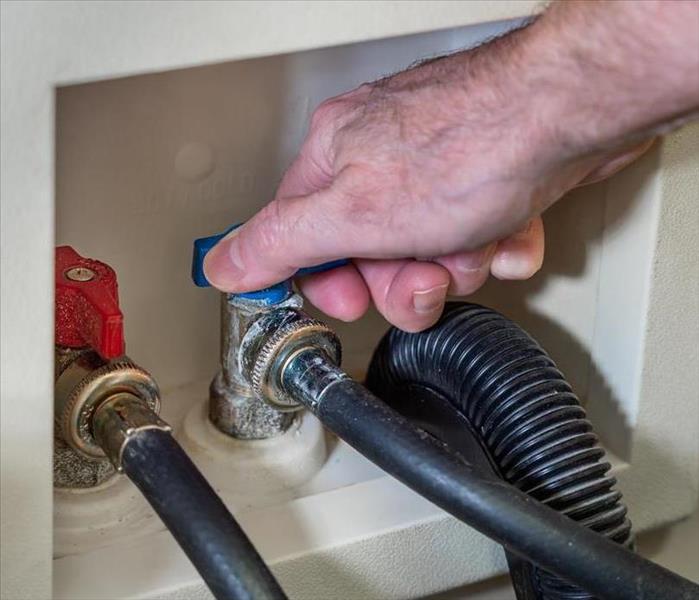 The longer a water loss sits, the worse it gets.
The longer a water loss sits, the worse it gets.
Water loss comes in many forms and depending on the type of water you're dealing with; it could affect your home in different ways. We've discussed Category 1 water and how it originates from a sanitary water source, such as a sink overflow situation. Should that water sit for two or three days, it could transition into a Category 2 water loss.
Category 2 water is often referred to as "greywater." While it is not grossly contaminated, there is enough contamination present to potentially make someone ill were the water ingested. These water sources include overflow from a washing machine or a dishwasher, toilet overflows containing some urine (but no feces), and even things like an overflowing aquarium or punctured waterbed. There are also microorganisms present in the water.
Once Category 2 water has been sitting for 48 hours or more, the bacteria multiply, and mold forms. This becomes Category 3 water, commonly referred to as "black water." This is extremely dangerous. Don't let it get to that point! Should you experience a Category 2 water loss, SERVPRO of Saline County and SERVPRO of Hot Springs are available 24/7 to start the mitigation progress and make your water loss "Like it never even happened." Call 501-776-2222.
We're always here to help.
Water Loss Categories: Category 1
4/14/2022 (Permalink)
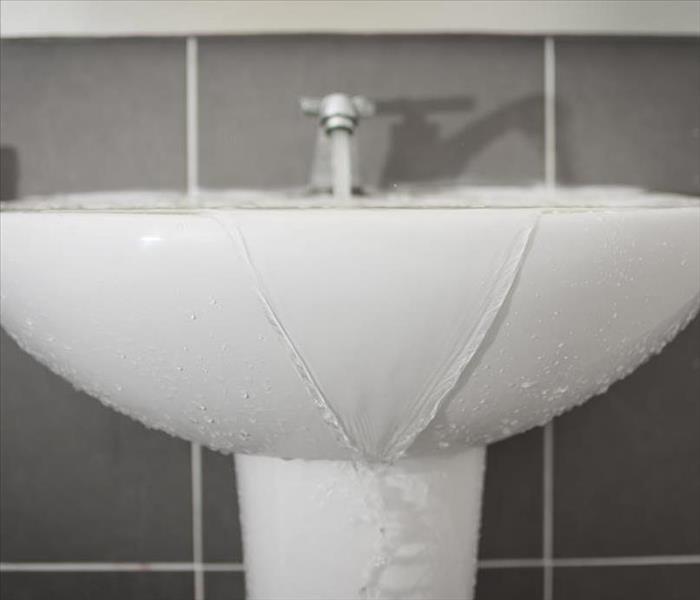 The clock starts ticking once you've experienced a Category 1 water loss!
The clock starts ticking once you've experienced a Category 1 water loss!
When you're dealing with a water loss, time is not on your side. The longer a water issue remains on your property, the more likely it is to turn into major damage, which could result in a lengthy restoration process.
Many water losses that occur in the home are considered a category 1 water loss. These involve sanitary sources of water, such as a bathtub or sink overflowing. Category 1 water poses no danger from exposure or ingestion. A broken toilet tank or bowl can be considered a category 1 water loss when the water has no contaminants. Even though these water sources are sanitary, they can damage laminate floors, plywood, particle board, and the like. Carpets are likely to escape long-term damage once the water is extracted.
Unless category 1 water damage is quickly scheduled for restorative drying, you run the risk of your water loss devolving into a category 2 or category 3 water loss. Give us a call when you first notice your water loss. We're always here to help.
SERVPRO of Saline County and SERVPRO of Hot Springs are available 24/7/365 to handle your emergency. Should you suffer a category 1 water loss, call 501-776-2222, and we'll make it "Like it never even happened."
Water Damage to Your Laminate Flooring
3/18/2022 (Permalink)
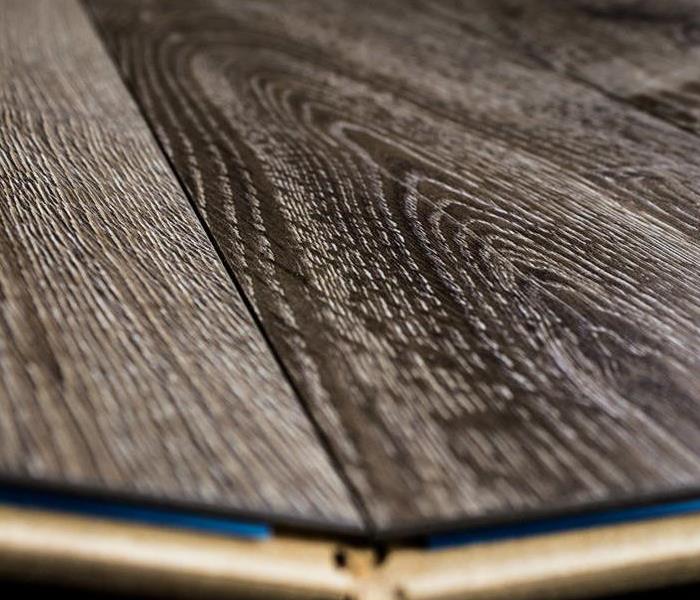 Water-damaged laminate usually needs to be pulled.
Water-damaged laminate usually needs to be pulled.
Laminate flooring is one of the most popular types of flooring in homes today. The lower price point and realistic wood finishes are the perfect choice for homeowners wanting to upgrade or renovate their homes with a luxury feel. The quality of the flooring has greatly improved over the years, with some brands claiming to offer waterproof laminate flooring. While this sounds ideal, the idea of completely waterproof laminate flooring is a bit misleading.
Many types of laminate flooring can withstand the wear and tear and occasional spills of everyday use. As long as a spill is wiped up immediately, most laminate stays in good shape. Should your home suffer water damage from other sources, such as a leaking appliance or burst pipe, the reality is that your flooring would most likely need to be replaced.
Laminate flooring is manufactured, so once the materials start to take on water, the underside starts to break down due to saturation. There are signs to look for if you think your laminate flooring might have water damage. The planks that typically lay flat could start splitting or bubbling. They could even buckle. If you notice discoloration or visible mold, your floor is definitely damaged and needs to be replaced.
Should you experience water damage, give the pros at SERVPRO of Saline County and SERVPRO of Hot Springs a call at 501-776-2222. We'll take out the damaged laminate and make it "Like it never even happened."
We're always here to help.
Water Damage in your Bryant, AR Condo
3/10/2022 (Permalink)
 Who is responsible if your condo's water damage came from another unit?
Who is responsible if your condo's water damage came from another unit?
Living in a multi-unit dwelling comes with its own set of pros and cons, but what happens when something goes wrong? Your home could experience water damage from another unit in the dwelling. What happens then? Are you responsible for getting it repaired yourself? Laws vary throughout the country, but the tricky answer is that “it depends.” Mostly, it depends on what was damaged and the location of the damage. Most condos and townhouses have a Homeowners Association (HOA) that spells out what happens when a unit is damaged. In many cases, the bylaws cover “common elements” and damage in a unit is the responsibility of the owner. Should an incident be caused by the negligence of one owner, resulting in damages to another owner's property, the negligent owner's liability insurance could come into play.
There are some things to look for to stop water damage before it becomes a problem. One of the major culprits is blocked gutters. Keep your gutters clean and clear so they don't overflow and cause an issue. It is also important to ensure your appliances are maintained. Dishwashers, refrigerators, and washing machines can leak into a neighbor's unit, and you would likely be on the hook for the bill. Follow a maintenance schedule for your appliances to keep them working properly. Does your condo or townhome have a sump pump? These are often the cause of water issues in multi-unit dwellings. While the HOA is usually the owner of the sump pump, they're sometimes located in a particular unit, meaning that the owner needs to make sure it is operating efficiently.
In short, make sure you are familiar with the bylaws of your multi-unit condo or townhome. Should any damage occur, it's a good idea to consult the bylaws to ensure you're following the proper steps to get the problem solved. Should your condo or townhome experience a water loss, give us a call at SERVPRO of Saline County and SERVPRO of Hot Springs. We're available 24/7 and quick to the scene to make it “Like it never even happened.”
Frozen Pipes in Hot Springs Village, AR
2/1/2022 (Permalink)
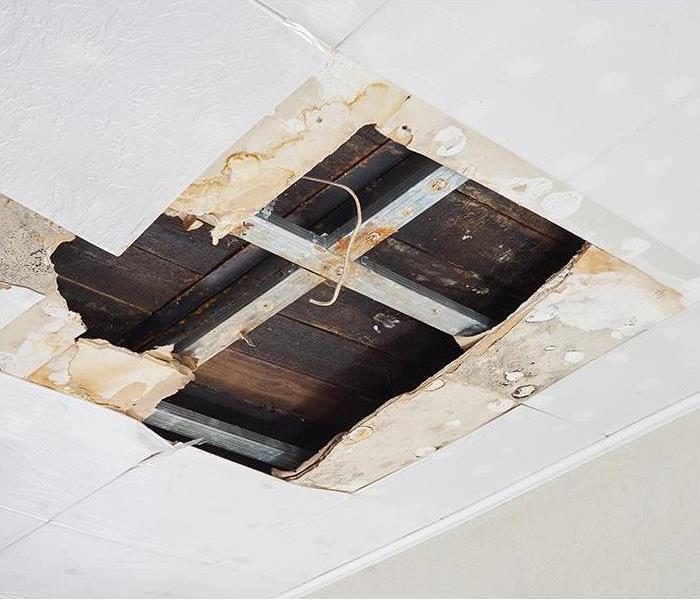 It shouldn't rain from the ceiling.
It shouldn't rain from the ceiling.
One thing is for sure about life in Arkansas - the weather is never what anyone would describe as "normal". This is especially true for our winters. A beautiful 70-degree day in January? Check that extended forecast because an ice storm could be on its way. Mild days often lead to frigid nights, which could lead to frozen pipes.
Yes, if the temperature drops low enough, your pipes could absolutely freeze during one cold night. Generally, pipes are susceptible to freezing once the outdoor temperatures reach or drop below 20 degrees. When a pipe freezes, the internal pressure increases. This is why frozen pipes sometimes burst.
Keep an eye on the forecast and do what you can to prevent your pipes from freezing. This is especially true if you have pipes in unheated areas of your home, like an attic or garage.
- Cover exposed pipes.
- Allow your faucets to slowly drip for the duration of the below-freezing temperatures.
- Open your cabinet doors. This allows the heat from your home to warm up areas it wouldn't normally reach. This is good for pipes near the exterior walls of your home.
- Leave your heat running if you're leaving home.
Sometimes things happen anyway. We hope it doesn't happen to you. But if it does, put our number in your phone:
SERVPRO of Saline County and SERVPRO of Hot Springs - 501-776-2222.
We're available 24/7 for water emergencies. We can make it "Like it never even happened."
We're always here to help.
Is it Mold or Mildew?
9/20/2021 (Permalink)
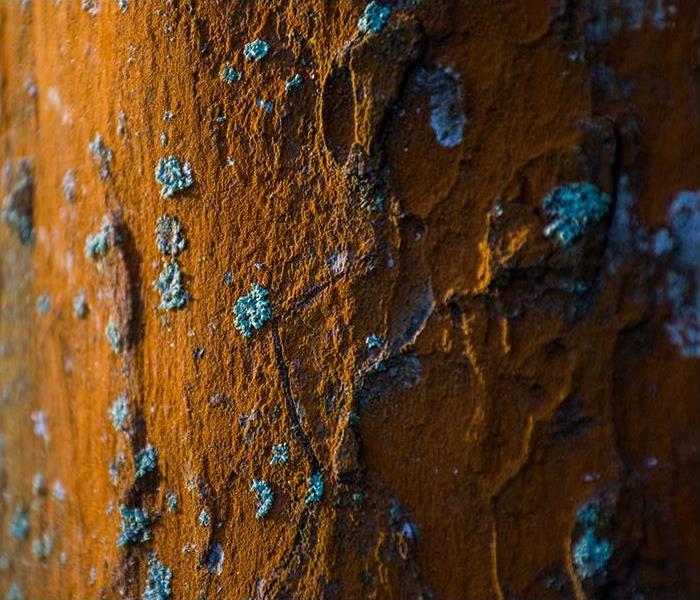 Not sure what it is? The color and texture hold several clues to whether you're dealing with mold or mildew.
Not sure what it is? The color and texture hold several clues to whether you're dealing with mold or mildew.
It's a little unsettling to see something growing in or on your home. Mold growth in a home is often a cause of concern for a homeowner, and a lot of times, they automatically assume the worst. Mold and mildew are often used interchangeably, but they are two different things with different forms of treatment. While spots generally need to be treated, first you need to know what it is in order to properly treat it.
Here is a quick rundown of a few major differences between mold and mildew:
Is the spot flat or is it more three-dimensional? Mildew is always flat, but mold is often raised.
What color is it? Mildew usually looks white or grey. It has a dry, or sometimes even powdery appearance. Mold is either red, blue, green, or black. It can look slimy or even fuzzy.
How does it smell? A musty smell like damp socks generally indicates mildew, but a pungent odor is more commonly found with mold.
It's important to remember that mold and mildew need to be stopped at the source, otherwise the problem is likely to return. Moisture is the key to their survival and reproduction, so the source of the excess moisture needs to be located and repaired.
Think you have a mold issue? We're always here to help! Give SERVPRO of Saline County and SERVPRO of Hot Springs a call at 501-776-2222, and we'd be happy to schedule an inspection and plan a course of action. We'll make it "Like it never even happened."
Category 3 Water Damage in Your Malvern, AR Home
7/14/2021 (Permalink)
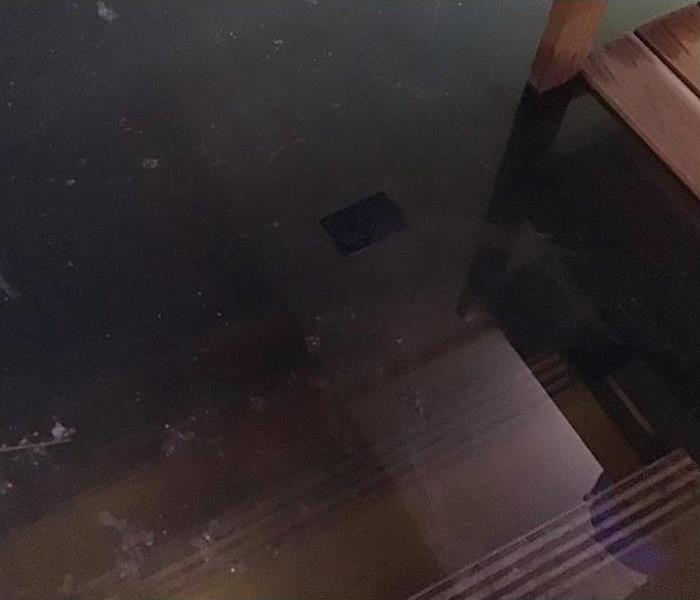 This Malvern, AR business suffered a Category 3 water loss when they discovered several feet of standing water in their basement.
This Malvern, AR business suffered a Category 3 water loss when they discovered several feet of standing water in their basement.
Water loss isn't the type of property damage that you can put off until later. An invisible stopwatch starts running from the moment the damage occurs, and the longer it lasts, the worse the damage can be. We've previously discussed Category 1 water, which comes from a sanitary source. We've also discussed "greywater," or Category 2 water, which happens when Category 1 water sits for more than a couple of days. It can also come from an overflowed washing machine, dishwasher, or toilet that does not contain feces. Category 2 water is very susceptible to bacterial invasion, and this is when your water loss turns serious. Should a Category 2 water loss sit for 48 hours, it is now classified as Category 3, commonly called "black water."
Aside from Category 2 water sitting for 48 hours, Category 3 water has many sources. A sewage backup is automatically classified as a Category 3 loss. Large rain events can cause flash flooding, which is also Category 3. Major storm damage, such as flooding from a hurricane is black water, too.
Take care to never ingest Category 3 water, either intentionally or accidentally. This water is extremely contaminated, and you could be exposed to serious diseases such as Hepatitis B and C, Tetanus, or even HIV.
Once your home suffers a Category 3 water loss, it is imperative to have it remedied immediately. Should that water sit in your home, it could soak not only the contents of your home, but also sheetrock, flooring, and anywhere else it can get. This poses a huge health risk to the occupants of the home.
SERVPRO of Saline County and SERVPRO of Hot Springs understand the severity involved with Category 3 water, and our specially-trained technicians are ready to make it "Like it never even happened." Call us today at 501-776-2222 to discuss your needs. We're available 24/7.
We're always here to help.
Category 2 Water Damage in Your Bauxite, AR Home
4/20/2021 (Permalink)
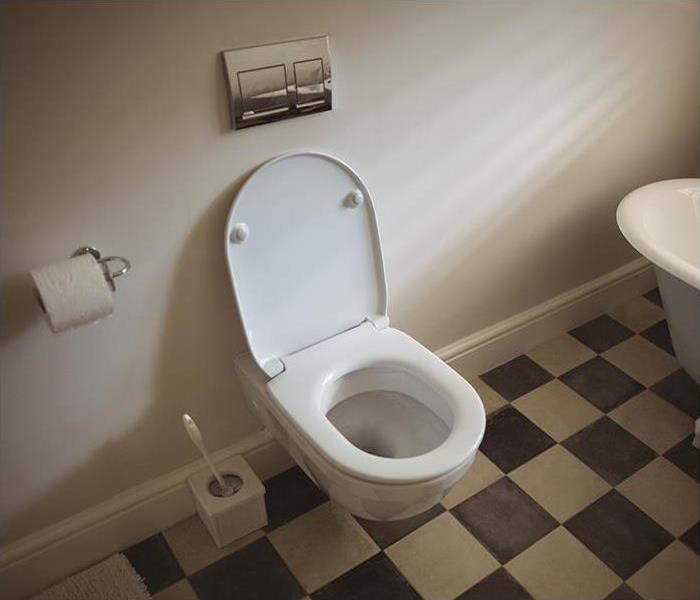 Have a greywater issue in your home? We're always here to help.
Have a greywater issue in your home? We're always here to help.
Water loss comes in many forms, and depending on the type of water you're dealing with, it could affect your home in different ways. We've discussed Category 1 water and how it originates from a sanitary water source, such as a sink overflow situation. Should that water sit for two or three days, it could transition into a Category 2 water loss.
Category 2 water is often referred to as "greywater." While it is not grossly contaminated, there is enough contamination present to potentially make someone ill were the water ingested. These water sources include overflow from a washing machine or a dishwasher, toilet overflows containing some urine (but no feces), and even things like an overflowing aquarium or punctured waterbed. There are also microorganisms present in the water.
Once Category 2 water has been sitting for 48 hours or more, the bacteria multiply, and mold forms. This becomes Category 3 water, commonly referred to as "black water." This is extremely dangerous. Don't let it get to that point! Should you experience a Category 2 water loss, SERVPRO of Saline County and SERVPRO of Hot Springs are available 24/7 to start the mitigation progress and make your water loss "Like it never even happened." Call 501-776-2222.
We're always here to help.
Category 1 Water Damage in Your Haskell, AR Home
4/15/2021 (Permalink)
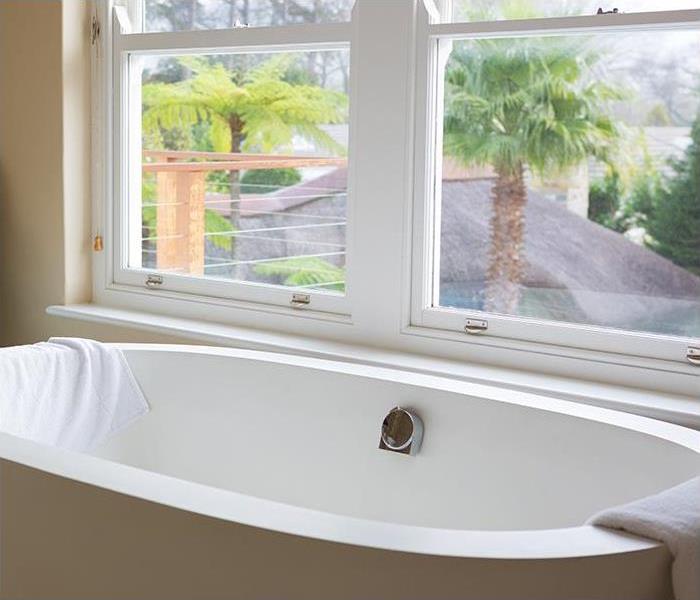 Should your bathtub overflow, give us a call to fix the damage before it turns into something much worse!
Should your bathtub overflow, give us a call to fix the damage before it turns into something much worse!
When you're dealing with a water loss, time is not on your side. The longer a water issue remains on your property, the more likely it is to turn into major damage, which could result in a lengthy restoration process.
Many water losses that occur in the home are considered a category 1 water loss. These involve sanitary sources of water, such as a bathtub or sink overflowing. Category 1 water poses no danger from exposure or ingestion. A broken toilet tank or bowl can be considered a category 1 water loss when the water has no contaminants. Even though these water sources are sanitary, they can damage laminate floors, plywood, particle board, and the like. Carpets are likely to escape long-term damage once the water is extracted.
Unless category 1 water damage is quickly scheduled for restorative drying, you run the risk of your water loss devolving into a category 2 or category 3 water loss. Give us a call when you first notice your water loss. We're always here to help.
SERVPRO of Saline County and SERVPRO of Hot Springs are available 24/7/365 to handle your emergency. Should you suffer a category 1 water loss, call 501-776-2222, and we'll make it "Like it never even happened."
How Does Water Affect Laminate Flooring?
3/26/2021 (Permalink)
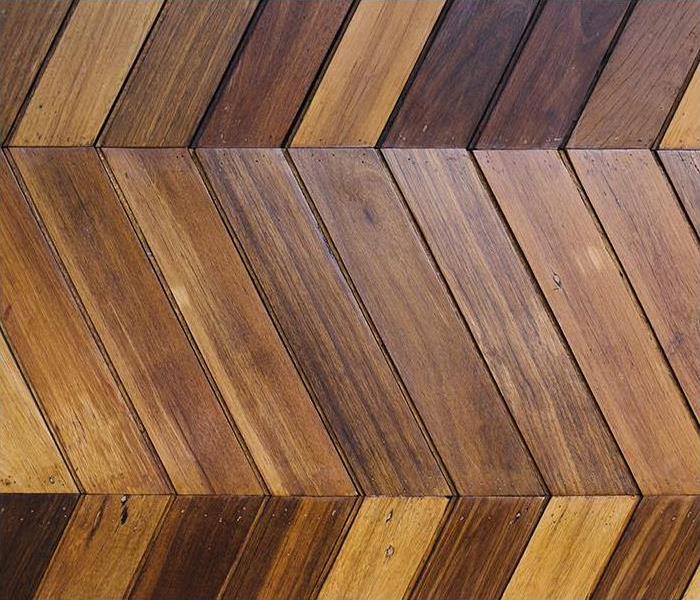 Water and laminate flooring do not mix.
Water and laminate flooring do not mix.
Laminate flooring is one of the most popular types of flooring in homes today. The lower price point and realistic wood finishes are the perfect choices for homeowners wanting to upgrade or renovate their homes with a luxury feel. The quality of the flooring has greatly improved over the years, with some brands claiming to offer waterproof laminate flooring. While this sounds ideal, the idea of completely waterproof laminate flooring is a bit misleading.
Many types of laminate flooring can withstand the wear and tear and occasional spills of everyday use. As long as a spill is wiped up immediately, most laminate stays in good shape. Should your home suffer water damage from other sources, such as a leaking appliance or burst pipe, the reality is that your flooring would most likely need to be replaced.
Laminate flooring is manufactured, so once the materials start to take on water, the underside starts to break down due to saturation. There are signs to look for if you think your laminate flooring might have water damage. The planks that typically lay flat could start splitting or bubbling. They could even buckle. If you notice discoloration or visible mold, your floor is definitely damaged and needs to be replaced.
Should you experience water damage, give the pros at SERVPRO of Saline County and SERVPRO of Hot Springs a call at 501-776-2222. We'll take out the damaged laminate and make it "Like it never even happened."
We're always here to help.
Water Damage in your Hot Springs, AR Townhouse
3/25/2021 (Permalink)
 Who is responsible if your townhome's water damage came from another unit?
Who is responsible if your townhome's water damage came from another unit?
Living in a multi-unit dwelling comes with its own set of pros and cons, but what happens when something goes wrong? Your home could experience water damage from another unit in the dwelling. What happens then? Are you responsible for getting it repaired yourself? Laws vary throughout the country, but the tricky answer is that “it depends.” Mostly, it depends on what was damaged and the location of the damage. Most condos and townhouses have a Homeowners Association (HOA) that spells out what happens when a unit is damaged. In many cases, the bylaws cover “common elements” and damage in a unit is the responsibility of the owner. Should an incident be caused by the negligence of one owner, resulting in damages to another owner's property, the negligent owner's liability insurance could come into play.
There are some things to look for to stop water damage before it becomes a problem. One of the major culprits is blocked gutters. Keep your gutters clean and clear so they don't overflow and cause an issue. It is also important to ensure your appliances are maintained. Dishwashers, refrigerators, and washing machines can leak into a neighbor's unit, and you would likely be on the hook for the bill. Follow a maintenance schedule for your appliances to keep them working properly. Does your condo or townhome have a sump pump? These are often the cause of water issues in multi-unit dwellings. While the HOA is usually the owner of the sump pump, they're sometimes located in a particular unit, meaning that the owner needs to make sure it is operating efficiently.
In short, make sure you are familiar with the bylaws of your multi-unit condo or townhome. Should any damage occur, it's a good idea to consult the bylaws to ensure you're following the proper steps to get the problem solved. Should your condo or townhome experience a water loss, give us a call at SERVPRO of Saline County and SERVPRO of Hot Springs. We're available 24/7 and quick to the scene to make it “Like it never even happened.”
How To Discover a Shower or Bathtub Leak
2/25/2021 (Permalink)
How to prevent water damage in your bathroom!
Indoor plumbing is one luxury of modern life, but a bathtub leak can quickly turn it into a stressful, expensive problem. If you want to prevent a water disaster from damaging your home, there are signs you can look for. Here are a few ways to find potential water leaks in your tub or shower.
Look for Signs
If you suspect you have a shower pan leak, there are several telltale signs you can search for. Here are some signs to look for when inspecting your home for leaks:
- Damp carpet
- Rusted floor nails
- Stains on the shower stall
- Water in the ceiling or light fixtures below
- Wet drywall
Some signs may not be immediately apparent, but you can do simple things to uncover them, such as pulling back a corner of the carpet to look for rusty floor nails. Another easy task is to inspect the drywall and floor surrounding the shower (or the ceiling on the floor below if you have a multi-story home). Some leaks may not be apparent while the water is off, so running the water while you search may make the leak easier to find.
Perform a Test
If you’re building a home in Saline County or remodeling an existing bathroom, a bathtub leak test may be appropriate. This a test often performed by professionals during home construction, so ask your contractor about it. To do the test, he or she will stop the drain, fill the tub to capacity and let it stand for at least 48 hours. It’s a simple way to discover potential leaks before other water damage-prone materials are installed.
Unfortunately, sometimes a bathtub leak isn’t discovered until the damage is already done, but a water damage repair specialist can help get your home back to normal. With these tips, you'll know what look for before the next water trickle becomes a flood.
Prevent Commercial Construction Plumbing Issues With Careful Monitoring
9/16/2020 (Permalink)
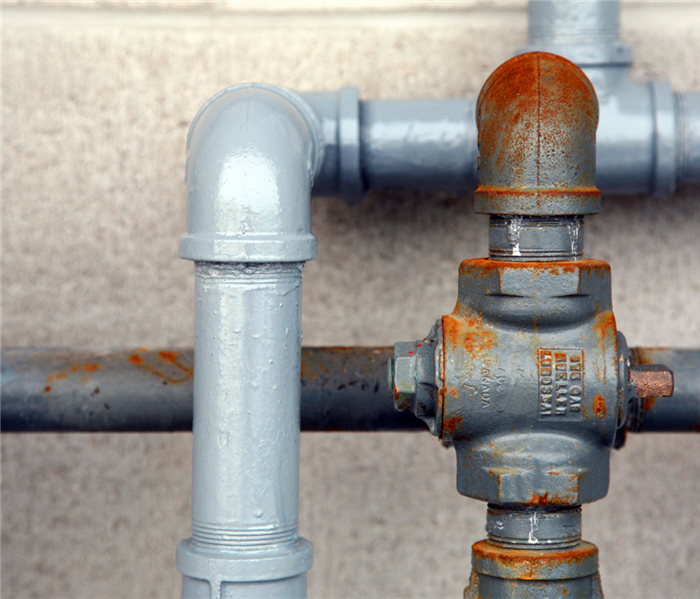 What can you do to prevent water damage?
What can you do to prevent water damage?
Nothing is more exciting to a business owner in Rockwell, AR than breaking ground on a new project.
The sight of construction workers scrambling and the sounds and smells of wood being cut and jackhammers going creates quite a bit of excitement. But once in a while plumbing problems such as a water pipe repair or a leaking water main can arise and can bring the job to a halt. Fortunately, there are a few things you can do to ensure that water issues can be avoided.
Four Steps to Preventing Water Damage During Construction
- Before beginning the project, make sure that the plans are checked and double checked for accuracy, including water tables and drainage issues.
- During construction, enforce a no-shortcuts rule and make sure all plumbing is quality checked, and that water issues are mitigated weekly.
- Toward the end of construction conduct thorough water-tightness testing. Check the roof, windows and doors, all drains and all piping systems for any broken pipe and perform any water pipe repair immediately.
- After construction, follow up with a punch list of all plumbing systems and see that they are all addressed.
There are several areas that should be monitored regularly for water leaks. These include window flashings and door openings and areas around roof vents, eaves and gutters, as well as mechanical and drainage systems, retention ponds and the entire plumbing system. Slacking off on checking these often can cost you a good deal if one of them fails and water enters the building. Of these, plumbing problems are probably the easiest to prevent and also the most devastating if they go wrong.
If you are however, faced with an elevator full of water or find that a toilet has flooded the entire third floor, call one of the emergency water restoration services in here in Hot Springs, AR to help with clean up and restoration. Water pipe repair and plumbing problems don’t need to create a costly slowdown on your project. Getting proper help will ensure that the job is done right and all is restored to its proper state.
Using a Thermal Camera To Detect Water Leaks
4/29/2020 (Permalink)
Water leaks often can be hidden behind walls and undetectable by the naked eye and can be cause serious problems to a home or building if not detected soon enough. However, using a thermal camera can be useful in locating water. Thermal cameras cannot show one hidden water, it can however show temperature differences and patterns which can indicate water. Moisture and water are some of the most difficult things to notice in a home or building. One may never know there is an issue until water begins dripping from the ceiling or leaking from under the floor. By using a thermal camera our highly trained technicians can help locate an issue without resorting to tearing out walls or ceilings. If you are concerned with a water issue in your home or commercial building give us a call at 501-776-2222.
3 Categories of Water Damage
4/29/2020 (Permalink)
According to the IICRC there are three categories of water damage. These three types determine how water restoration is managed.
Category 1
Category 1 is a source of water that is classified as “clean water” meaning it is not harmful to humans. Some examples are if a tub or sink overflow or broken water supply line.
Category 2
Category 2 water contains chemical, biological or physical contaminants and can cause sickness to humans. This category is sometimes called “grey water,” and caries microorganisms. Some examples include dishwasher or washing machine overflow or a sum pump failure.
Category 3
The most harmful to humans because it contains unsanitary agents, harmful bacteria and fungi. Category 3 is sometimes called “black water” and can cause severe sickness and discomfort. Examples include water sources from flood water, sewage, and category 2 water that was not properly remediated and has become stagnant.
SERVPRO of Saline County and Hot Springs are highly trained to remediate the different categories of water. If you have a water loss we are “here to help.”
Water Heater Maintenance to Prevent Water Damage to your Saline County Home
1/28/2020 (Permalink)
One of the main causes for a residential water loss is the hot water heater. The life span of most electric hot water heaters is eight to twelve years and most manufacturers recommend replacing them at year ten. Gas hot water heaters last approximately six to eight years with tank less hot water heaters lasting up to 20 years. The design of a home can place the hot water heater in the garage, an interior closet and even in the attic. A water loss caused by a leaking or even burst hot water heater can cause several thousands of dollars in damage. Make sure your hot water heater is checked regularly by your plumber and is in good working order. If you happen to have an unfortunate event of a leaking or burst hot water heater, call SERVPRO of Saline County and SERVPRO or Hot Springs! We can make it “Like it never even happened.”
Preventing water loss in your pool
6/21/2019 (Permalink)
Exposure to intense heat, wind, and low humidity can all cause you to suffer water loss in your backyard or commercial swimming pool. This can be very costly and disappointing when you are looking to cool off during the harsh summer months. There are several ways you can combat evaporation of water from your pool.
- Use a Pool Cover: Pool covers are the best way to prevent water loss because they will reduce evaporation by 95%. Additionally, they will decrease chemical consumption and cleaning time.
- Turn off Your Water Features: fountains, slides, and sprayers all leave much more water exposed to the air causing rapid evaporation. When these features are not being used, remember to turn them off.
- Install Windbreakers: creating barriers to protect against wind (e.g. panels, fences, shrubs) will also protect your pool against excess evaporation.
Implementing these tips will save you money, energy, and water while still letting you enjoy the benefits of your pool!
Flooding in Saline County
4/23/2019 (Permalink)
Thursday, April 18, 2019 was a very busy day for our SERVPRO crew. Rain in Saline County caused water damage and flooding throughout the area. Our team was called out to several home that had roof damage and rain was pouring inside homes. We also were called out to extract water from flood damaged homes.
Our team worked long hours and showed compassion and sincere concern for our customers because at SERVPRO we truly care and love what we do. We understand that these circumstances can be very tragic and we are here to help.
We have received many testimonials and comments about our outstanding crew members. So if you or your family suffer from a disaster, big or small, and you are looking for a company that genuinely cares, give us a call at 501-776-2222.
Sewage Damage to your home or business
4/23/2019 (Permalink)
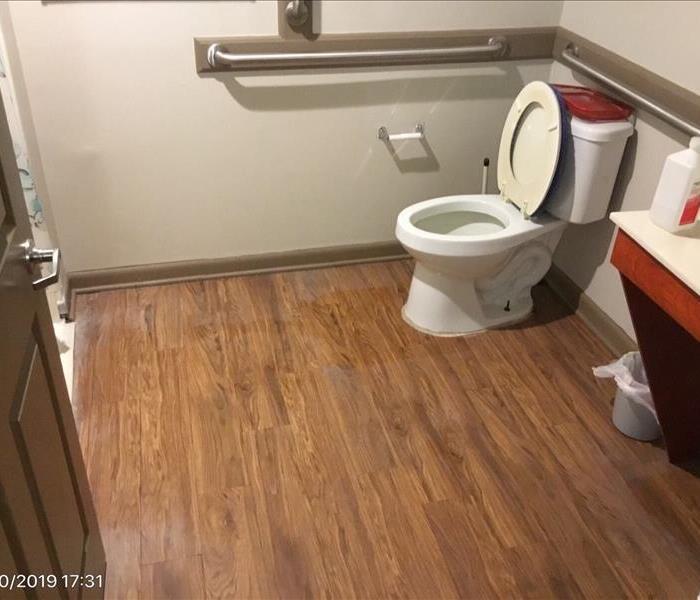 This is an image of a bathroom after a sewage loss. Our team was able to extract all the water and begin the drying and remediation process.
This is an image of a bathroom after a sewage loss. Our team was able to extract all the water and begin the drying and remediation process.
SERVPRO of Saline County and SERVPRO of Hot Springs technicians are trained and experienced in all levels of water mitigation. But, that doesn't always mean clean water. That also means "category 3" water. "Category 3" is described as unclean water. This may include flood water and sometimes sewage water. Flood and sewage water should be handled and treated by a trained technician.
SERVPRO of Saline County and SERVPRO of Hot Springs has the equipment to extract the water and materials, apply a disinfectant and remove porous materials that have been affected. This includes but is not limited to, carpet and pad, sheet rock and baseboards, and hardwood or laminate flooring. We will then take appropriate measures to dry all other materials and monitor the progress daily. We will then treat and disinfect so you can rebuild and get back to normal.
So, when your home or business is affected by unsanitary water, give us a call at 501-776-2222
Winter Weather Tips
1/25/2019 (Permalink)
Winter weather can wreak havoc on your home. Some of these damages can come from accumulation of snow on your roof or damage from ice. Here are a few solutions to help you protect your home from winter weather.
- Protect your pipes-As we all know water expands when it freezes. If there is water inside your pipes, when temperatures get too low, it can cause the water inside to expand and your pipes will burst or crack. Here are a few tips to prevent your pipes from bursting.
- Drain water from outdoor sprinklers and faucets.
- Disconnect outdoor hoses and use foam insulators to cover the faucets.
- If you have water pipes that run through unheated areas of your home, protect those pipes with insulation.
- Protect your roof from ice dams-Ice dams form from heat escaping through your roof and melts snow that has formed there. This melted snow then travels to the edge of your roof and refreezes. When the ice dam melts, the water doesn’t have anywhere to drain so it can cause a leak in your roof. There are simple easy steps to protect your roof and prevent ice dams from forming.
- Clean your gutters and downspouts. This allows water to continue to flow throughout the winter.
- Seal areas that may allow warm are to leak to your attic. Some of these areas may be, vent pipes, exhaust fans, chimneys, attic hatches, and light fixtures.
If you experience damage from winter weather, SERVPRO of Saline County and SERVPRO or Hot Springs is here to help. We are available 24/7 and our experienced team is ready when disaster strikes.
 This bathroom flooded after a pipe connected to the water heater ruptured and spread throughout the home.
This bathroom flooded after a pipe connected to the water heater ruptured and spread throughout the home.

 24/7 Emergency Service
24/7 Emergency Service













